Development of Operation Strategy for Battery Energy Storage System into Hybrid AC Microgrids
Abstract
1. Introduction
2. Theoretical Reference
2.1. Literature Review
2.2. Microgrids
2.3. BESS Applications
2.3.1. Energy Arbitrage
2.3.2. Increase Electric Supply Capacity
2.3.3. Upgrade Deferral
2.3.4. Black Start
2.3.5. Load Leveling
2.3.6. Power Smoothing
2.3.7. Clipping Recapture
2.3.8. Capacity Reserve
2.3.9. Frequency and Voltage Regulation
2.3.10. Virtual Inertia
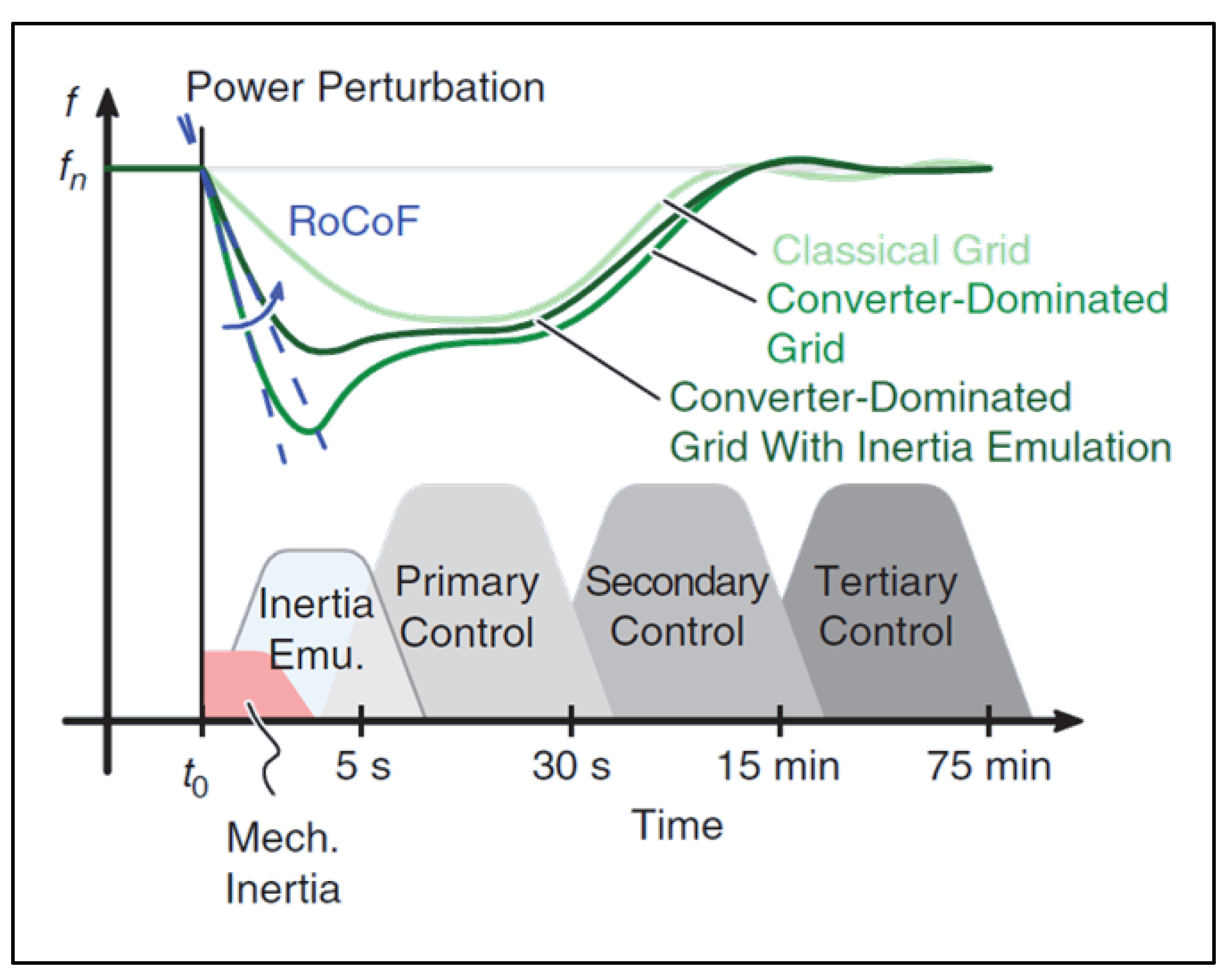
3. Methodology
3.1. Applications
3.1.1. Excess Energy Recapture
3.1.2. Power Smoothing of Photovoltaic Generation
3.1.3. Capacity Reserve
3.2. Proposed System
3.3. Simulations and Results Analysis
- Diesel consumption (L);
- Surplus Energy (kWh);
- Energy Recharged by BESS (kWh);
- PV generation (kWh);
- PV share in the energy matrix (%)
- Hours of Operation of Gensets (h);
- Average operating power of Gensets (kW);
- Percentage of Gensets power variation within the established limits (%);
- Variation in the average power of the Gensets;
- Distribution of power variation bands for Gensets.
4. Results
4.1. Energy Balance
4.2. Capacity Reserve
4.3. Power Smoothing
5. Conclusions
Author Contributions
Funding
Institutional Review Board Statement
Informed Consent Statement
Data Availability Statement
Conflicts of Interest
References
- Dayalan, S.; Gul, S.S.; Rathinam, R.; Fernandez Savari, G.; Aleem, S.H.A.; Mohamed, M.A.; Ali, Z.M. Multi-Stage Incentive-Based Demand Response Using a Novel Stackelberg–Particle Swarm Optimization. Sustainability 2022, 14, 10985. [Google Scholar] [CrossRef]
- Chen, W.; Liu, B.; Nazir, M.S.; Abdalla, A.N.; Mohamed, M.A.; Ding, Z.; Bhutta, M.S.; Gul, M. An Energy Storage Assessment: Using Frequency Modulation Approach to Capture Optimal Coordination. Sustainability 2022, 14, 8510. [Google Scholar] [CrossRef]
- Peng, F.; Su, H.; Li, P.; Song, G.; Zhao, J. An Interactive Operation Strategy for Microgrid Cooperated with Distribution System Based on Demand Response; IEEE: New York, NY, USA, 2015; ISBN 9781467371063. [Google Scholar]
- Zhang, Y.; Liu, B.; Zhang, T.; Guo, B. An Intelligent Control Strategy of Battery Energy Storage System for Microgrid Energy Management under Forecast Uncertainties. Int. J. Electrochem. Sci. 2014, 9, 4190–4204. [Google Scholar]
- Khalid, M. A Review on the Selected Applications of Battery-Supercapacitor Hybrid Energy Storage Systems for Microgrids. Energies 2019, 12, 4559. [Google Scholar] [CrossRef]
- Huang, Y.; Masrur, H.; Shigenobu, R.; Hemeida, A.M.; Mikhaylov, A.; Senjyu, T. A Comparative Design of a Campus Microgrid Considering a Multi-Scenario and Multi-Objective Approach. Energies 2021, 14, 2853. [Google Scholar] [CrossRef]
- Aziz, A.S.; Tajuddin, M.F.N.; Adzman, M.R.; Ramli, M.A.M.; Mekhilef, S. Energy Management and Optimization of a PV/Diesel/Battery Hybrid Energy System Using a Combined Dispatch Strategy. Sustainability 2019, 11, 683. [Google Scholar] [CrossRef]
- Arévalo-Cordero, P.; Benavides, D.J.; Espinoza, J.L.; Hernández-Callejo, L.; Jurado, F. Optimal Energy Management Strategies to Reduce Diesel Consumption for a Hybrid Off-Grid System. Rev. Fac. Ing. 2020, 98, 47–58. [Google Scholar] [CrossRef]
- Delille, G.; François, B.; Malarange, G. Dynamic Frequency Control Support: A Virtual Inertia Provided by Distributed Energy Storage to Isolated Power Systems. In Proceedings of the 2010 IEEE PES Innovative Smart Grid Technologies Conference Europe (ISGT Europe), Gothenburg, Sweden, 11–13 October 2010; pp. 1–8. [Google Scholar]
- Denholm, P.; Margolis, R.M. Evaluating the Limits of Solar Photovoltaics (PV) in Electric Power Systems Utilizing Energy Storage and Other Enabling Technologies. Energy Policy 2007, 35, 4424–4433. [Google Scholar] [CrossRef]
- Zhao, B.; Zhang, X.; Li, P.; Wang, K.; Xue, M.; Wang, C. Optimal Sizing, Operating Strategy and Operational Experience of a Stand-Alone Microgrid on Dongfushan Island. Appl. Energy 2014, 113, 1656–1666. [Google Scholar] [CrossRef]
- Vieira, G.T.T.; Pereira, D.F.; Taheri, S.I.; Khan, K.S.; Salles, M.B.C.; Guerrero, J.M.; Carmo, B.S. Optimized Configuration of Diesel Engine-Fuel Cell-Battery Hybrid Power Systems in a Platform Supply Vessel to Reduce CO2 Emissions. Energies 2022, 15, 2184. [Google Scholar] [CrossRef]
- Mohamed, M.A. A relaxed consensus plus innovation based effective negotiation approach for energy cooperation between smart grid and microgrid. Energy 2022, 252, 123996. [Google Scholar] [CrossRef]
- Ralon, P.; Taylor, M.; Ilas, A.; Diaz-Bone, H.; Kairies, K. Electricity Storage and Renewables: Costs and Markets to 2030; International Renewable Energy Agency: Abu Dhabi, United Arab Emirates, 2017; ISBN 9789292600389. [Google Scholar]
- Mohamad, F.; Teh, J.; Lai, C.M. Optimum allocation of battery energy storage systems for power grid enhanced with solar energy. Energy 2021, 223, 120105. [Google Scholar] [CrossRef]
- Ramos, F.O.; Neto, M.M.B.; Pinheiro, A.L.; Junior, W.A.S.; Lima, R.N. A Real Case Analysis of a Battery Energy Storage System for Energy Time Shift, Demand Management, and Reactive Control. In Proceedings of the 2021 IEEE PES Innovative Smart Grid Technologies Conference-Latin America (ISGT Latin America), Quito, Ecuador, 15 September 2021. [Google Scholar]
- Metwaly, M.K.; Teh, J. Optimum network ageing and battery sizing for improved wind penetration and reliability. IEEE Access 2020, 8, 118603–118611. [Google Scholar] [CrossRef]
- Ribeiro, P.F.; Johnson, B.K.; Crow, M.L.; Arsoy, A.; Liu, Y. Energy Storage Systems for Advanced Power Applications. Proc. IEEE 2001, 89, 1744–1756. [Google Scholar] [CrossRef]
- Fidalgo, J.N.; Couto, M.; Fournié, L. The worth of network upgrade deferral in distribution systems—Truism or myth? Electr. Power Syst. Res. 2016, 137, 96–103. [Google Scholar] [CrossRef]
- Liu, L.; Wang, Y.; Zhao, Y. The Energy Storage System Control Research Based on Black-Start. In Proceedings of the 2014 China International Conference on Electricity Distribution (CICED), Shenzhen, China, 23 September 2014; pp. 1472–1476. [Google Scholar]
- Mielczarski, W. Impact of Energy Storage on Load Balancing. In Proceedings of the 2018 15th International Conference on the European Energy Market (EEM), Lodz, Poland, 27–29 June 2018; Institute of Electrical and Electronics Engineers (IEEE): New York, NY, USA, 2018; pp. 1–5. [Google Scholar]
- Izidio, D.M.F.; de Mattos Neto, P.S.G.; Barbosa, L.; de Oliveira, J.F.L.; da Marinho, M.H.N.; Rissi, G.F. Evolutionary Hybrid System for Energy Consumption Forecasting for Smart Meters. Energies 2021, 14, 1794. [Google Scholar] [CrossRef]
- IRENA. Renewable Capacity Statistics 2020; International Renewable Energy Agency: Abu Dhabi, United Arab Emirates, 2020; ISBN 9789292602390. [Google Scholar]
- de Mattos Neto, P.S.G.; de Oliveira, J.F.L.; Domingos, D.S.; Siqueira, H.V.; Marinho, M.H.N.; Madeiro, F. An Adaptive Hybrid System Using Deep Learning for Wind Speed Forecasting. Inf. Sci. 2021, 581, 495–514. [Google Scholar] [CrossRef]
- Mohamed, M.A.; Almalaq, A.; Abdullah, H.M.; Alnowibet, K.A.; Alrasheedi, A.F.; Zaindin, M.S.A. A distributed stochastic energy management framework based-fuzzy-PDMM for smart grids considering wind park and energy storage systems. IEEE Access 2021, 9, 46674–46685. [Google Scholar] [CrossRef]
- Haque, M.E.; Sakib Khan, M.N.; Islam Sheikh, M.R. Smoothing Control of Wind Farm Output Fluctuations by Proposed Low Pass Filter, and Moving Averages; International Conference on Electrical & Electronics Engineering: New York, NY, USA, 2015; ISBN 9781467378192. [Google Scholar]
- Alevizakos, V.; Chatterjee, K.; Koukouvinos, C.; Lappa, A. A Double Moving Average Control Chart. Commun. Stat. Simul. Comput. 2020, 37, 1696–1708. [Google Scholar] [CrossRef]
- Martins, J.; Spataru, S.; Sera, D.; Stroe, D.I.; Lashab, A. Comparative Study of Ramp-Rate Control Algorithms for PV with Energy Storage Systems. Energies 2019, 12, 1342. [Google Scholar] [CrossRef]
- Mohamed, M.A.; Abdullah, H.M.; Al-Sumaiti, A.S.; El-Meligy, M.A.; Sharaf, M.; Soliman, A.T. Towards energy management negotiation between distributed AC/DC networks. IEEE Access 2020, 8, 215438–215456. [Google Scholar] [CrossRef]
- Al-Shamma’a, A.A.; Hussein Farh, H.M.; Noman, A.M.; Al-Shaalan, A.M.; Alkuhayli, A. Optimal Sizing of a Hybrid Renewable Photovoltaic-Wind System-Based Microgrid Using Harris Hawk Optimizer. Int. J. Photoenergy 2022, 2022, 4825411. [Google Scholar] [CrossRef]
- Teh, J.; Lai, C.M. Reliability impacts of the dynamic thermal rating and battery energy storage systems on wind-integrated power networks. Sustain. Energy Grids Netw. 2019, 20, 100268. [Google Scholar] [CrossRef]
- Al-Shamma’a, A.A.; Alturki, F.A.; Farh, H.M. Techno-economic assessment for energy transition from diesel-based to hybrid energy system-based off-grids in Saudi Arabia. Energy Transit. 2020, 4, 31–43. [Google Scholar] [CrossRef]
- Zeng, L.; Xia, T.; Elsayed, S.K.; Ahmed, M.; Rezaei, M.; Jermsittiparsert, K.; Dampage, U.; Mohamed, M.A. A novel machine learning-based framework for optimal and secure operation of static VAR compensators in EAFs. Sustainability 2021, 13, 5777. [Google Scholar] [CrossRef]
- Unamuno, E.; Paniagua, J.; Barrena, J.A. Unified Virtual Inertia for Ac and Dc Microgrids. IEEE Electrif. Mag. 2019, 7, 56–68. [Google Scholar] [CrossRef]
- Pinheiro, A.L.; Ramos, F.O.; Neto, M.M.B.; Lima, R.N.; Bezerra, L.G.S.; Junior, W.A.S. A Review and Comparison of Smoothing Methods for Solar Photovoltaic Power Fluctuation Using Battery Energy Storage Systems. In Proceedings of the 2021 IEEE PES Innovative Smart Grid Technologies Conference-Latin America (ISGT Latin America), Quito, Ecuador, 15 September 2021. [Google Scholar]
- Caterpillar Inc. C18 500kW Diesel Generator Sets; Caterpillar Inc.: Peoria, IL, USA, 2019. [Google Scholar]
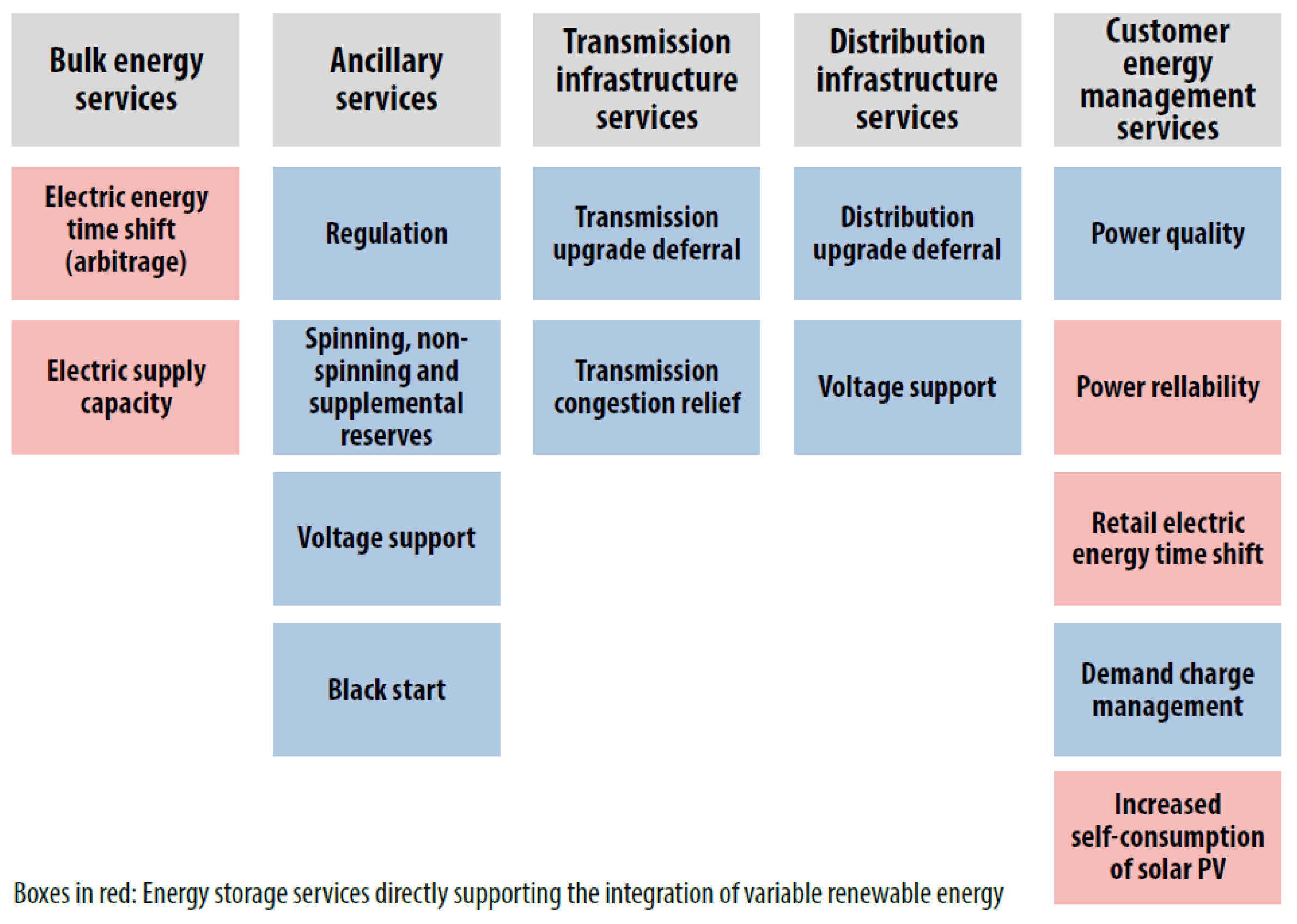










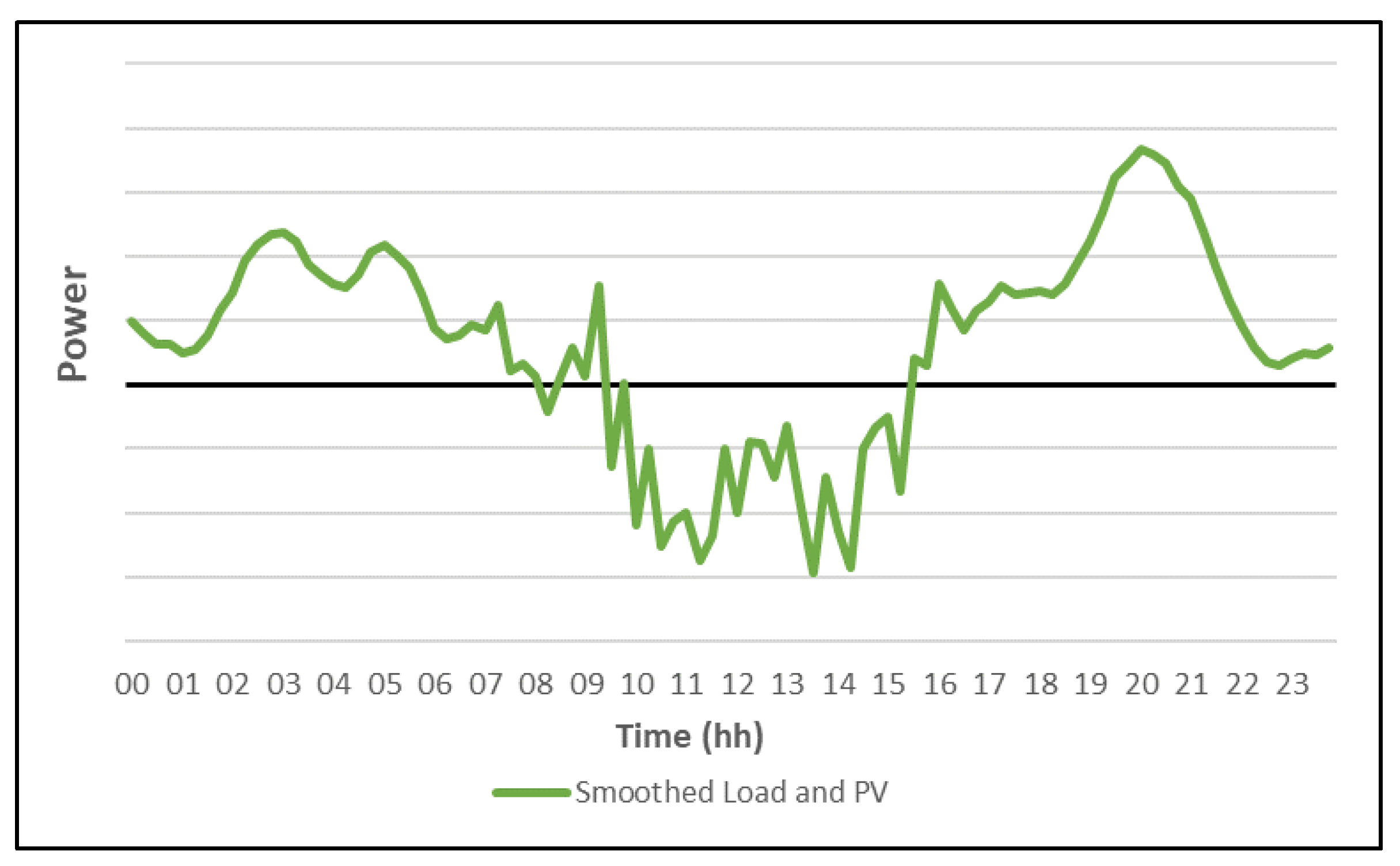


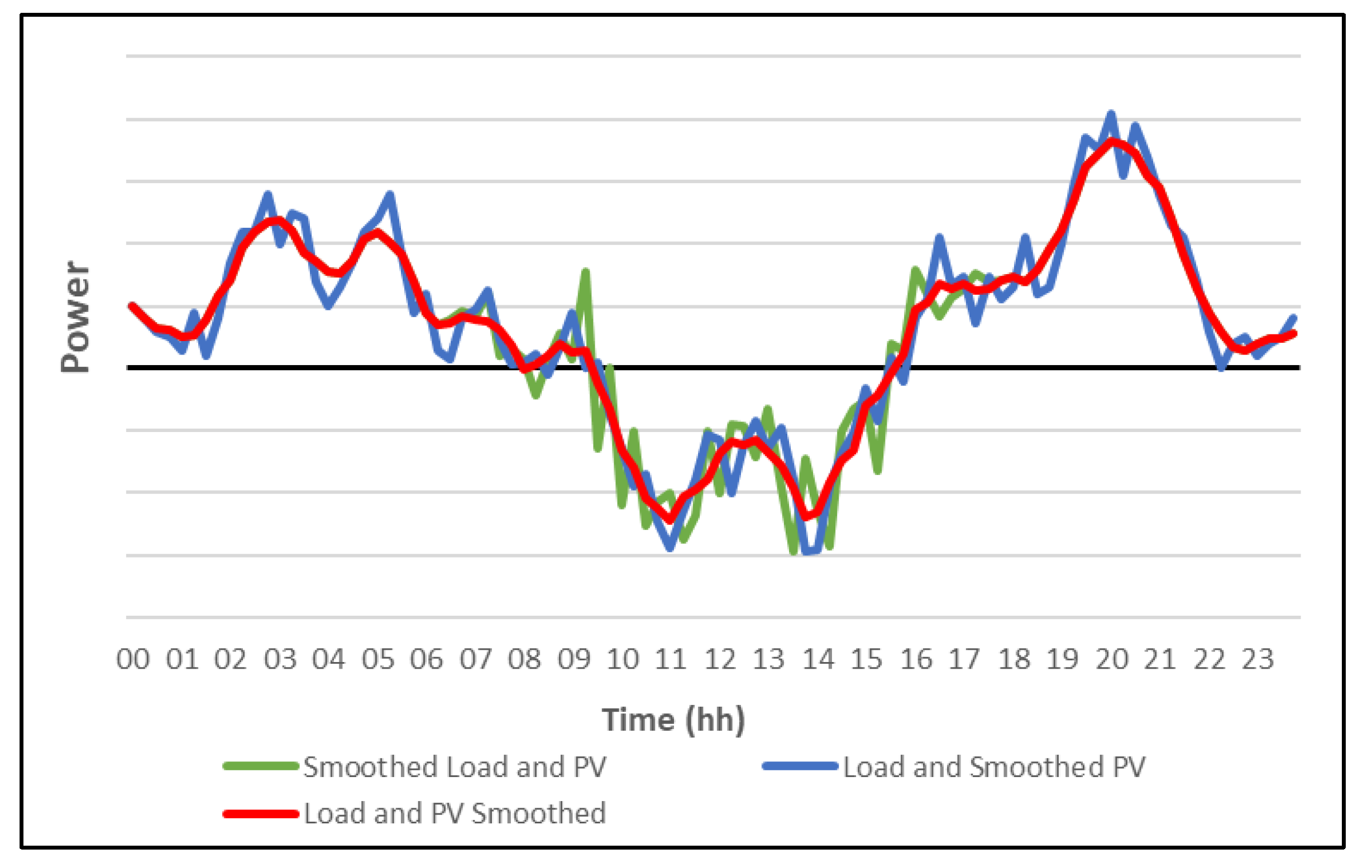
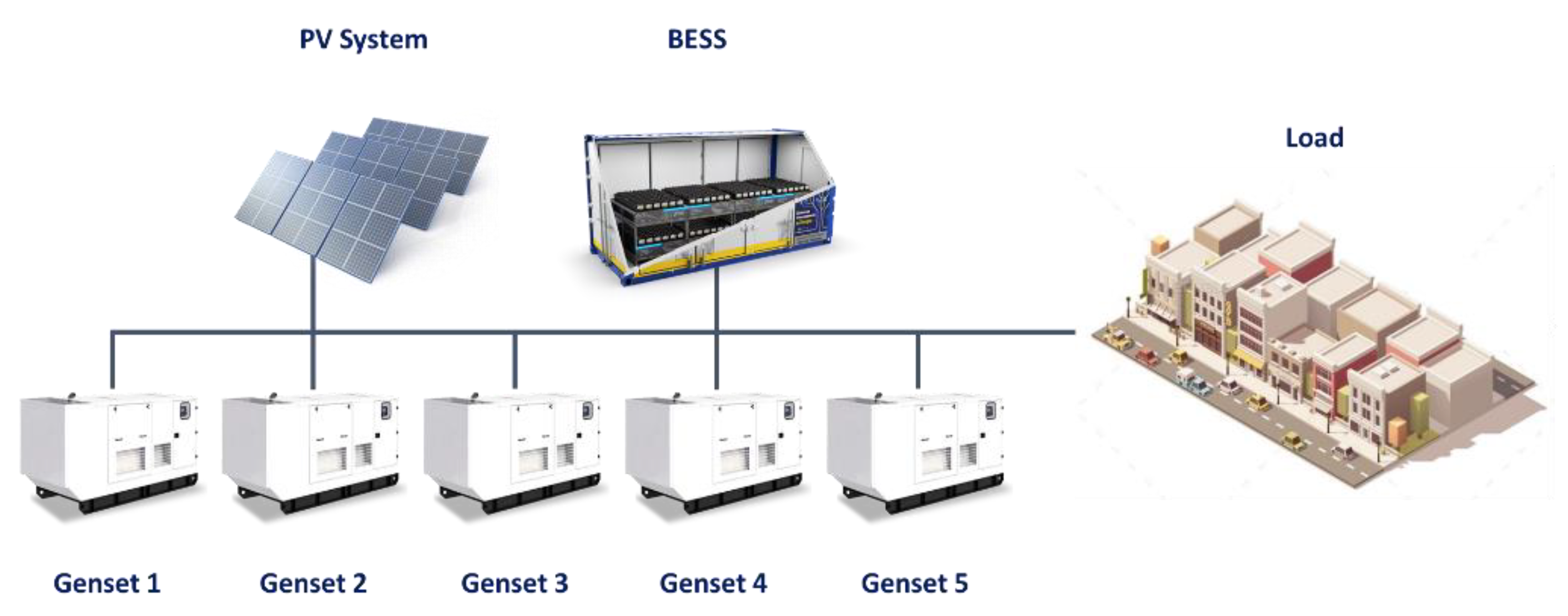
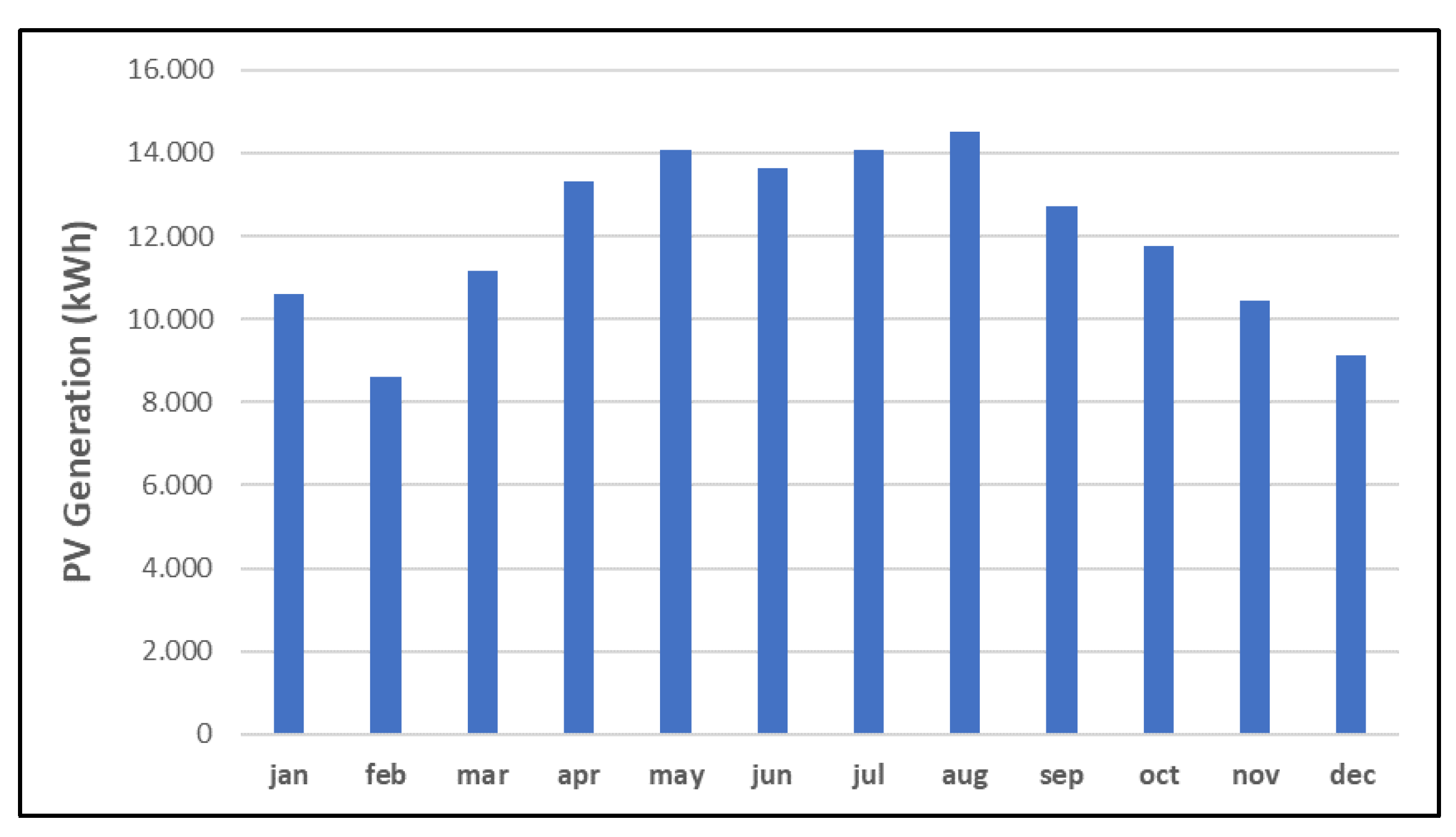




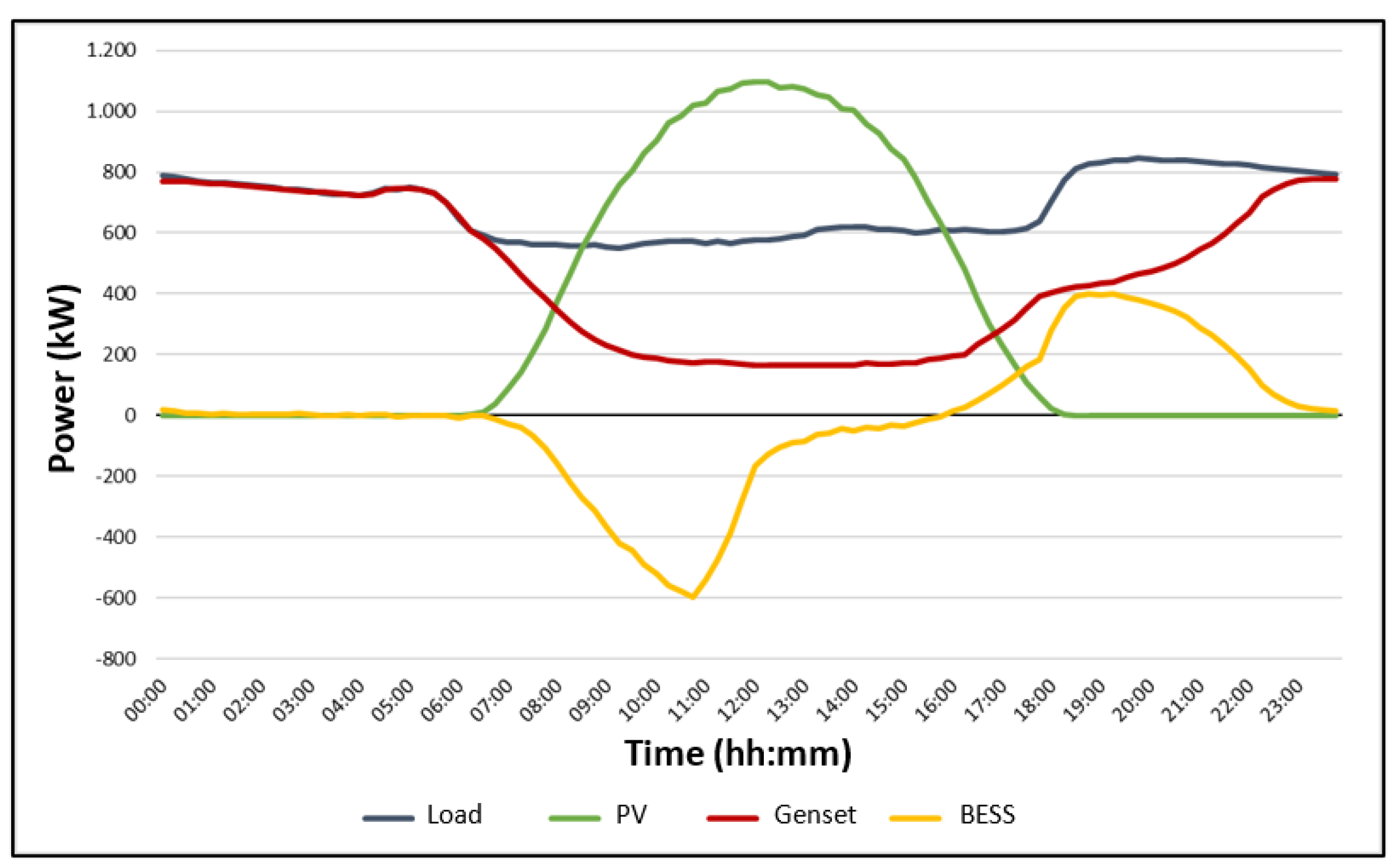





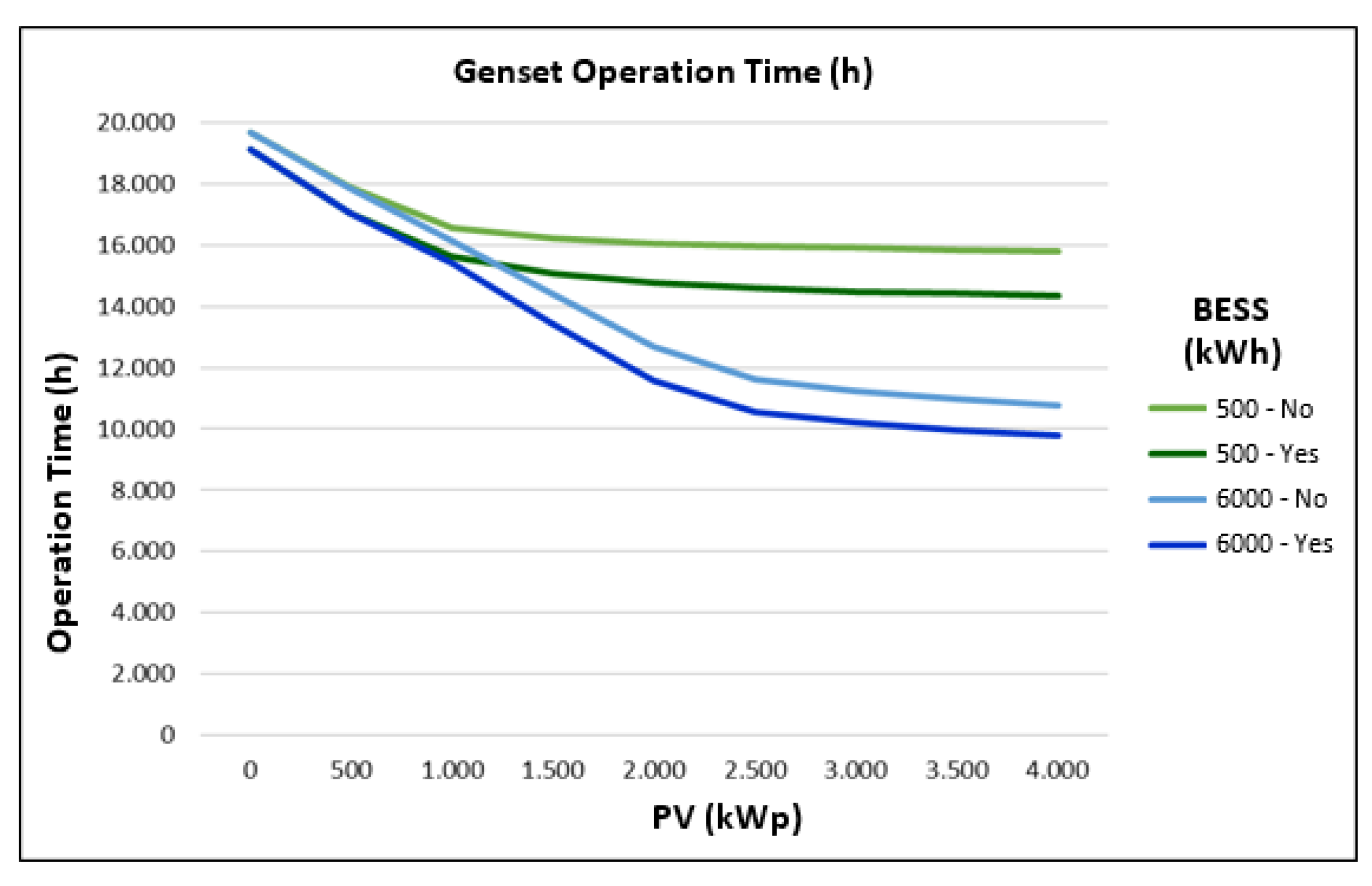







Publisher’s Note: MDPI stays neutral with regard to jurisdictional claims in published maps and institutional affiliations. |
© 2022 by the authors. Licensee MDPI, Basel, Switzerland. This article is an open access article distributed under the terms and conditions of the Creative Commons Attribution (CC BY) license (https://creativecommons.org/licenses/by/4.0/).
Share and Cite
Ramos, F.; Pinheiro, A.; Nascimento, R.; de Araujo Silva Junior, W.; Mohamed, M.A.; Annuk, A.; Marinho, M.H.N. Development of Operation Strategy for Battery Energy Storage System into Hybrid AC Microgrids. Sustainability 2022, 14, 13765. https://doi.org/10.3390/su142113765
Ramos F, Pinheiro A, Nascimento R, de Araujo Silva Junior W, Mohamed MA, Annuk A, Marinho MHN. Development of Operation Strategy for Battery Energy Storage System into Hybrid AC Microgrids. Sustainability. 2022; 14(21):13765. https://doi.org/10.3390/su142113765
Chicago/Turabian StyleRamos, Felipe, Aline Pinheiro, Rafaela Nascimento, Washington de Araujo Silva Junior, Mohamed A. Mohamed, Andres Annuk, and Manoel H. N. Marinho. 2022. "Development of Operation Strategy for Battery Energy Storage System into Hybrid AC Microgrids" Sustainability 14, no. 21: 13765. https://doi.org/10.3390/su142113765
APA StyleRamos, F., Pinheiro, A., Nascimento, R., de Araujo Silva Junior, W., Mohamed, M. A., Annuk, A., & Marinho, M. H. N. (2022). Development of Operation Strategy for Battery Energy Storage System into Hybrid AC Microgrids. Sustainability, 14(21), 13765. https://doi.org/10.3390/su142113765







